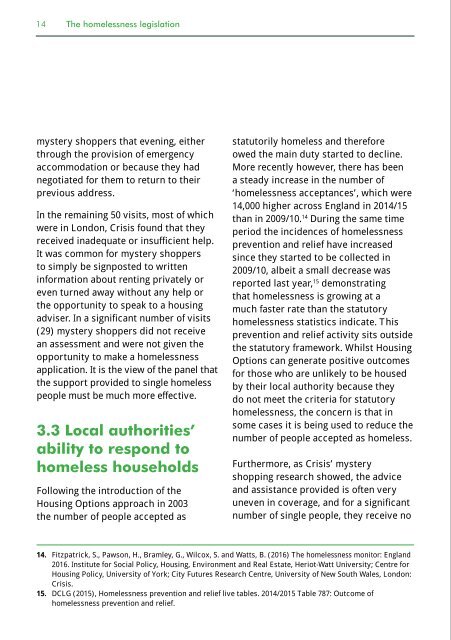The homelessness legislation
The%20homelessness%20legislation,%20an%20independent%20review%20of%20the%20legal%20duties%20owed%20to%20homeless%20people
The%20homelessness%20legislation,%20an%20independent%20review%20of%20the%20legal%20duties%20owed%20to%20homeless%20people
Create successful ePaper yourself
Turn your PDF publications into a flip-book with our unique Google optimized e-Paper software.
14 <strong>The</strong> <strong>homelessness</strong> <strong>legislation</strong> 15<br />
mystery shoppers that evening, either<br />
through the provision of emergency<br />
accommodation or because they had<br />
negotiated for them to return to their<br />
previous address.<br />
In the remaining 50 visits, most of which<br />
were in London, Crisis found that they<br />
received inadequate or insufficient help.<br />
It was common for mystery shoppers<br />
to simply be signposted to written<br />
information about renting privately or<br />
even turned away without any help or<br />
the opportunity to speak to a housing<br />
adviser. In a significant number of visits<br />
(29) mystery shoppers did not receive<br />
an assessment and were not given the<br />
opportunity to make a <strong>homelessness</strong><br />
application. It is the view of the panel that<br />
the support provided to single homeless<br />
people must be much more effective.<br />
3.3 Local authorities’<br />
ability to respond to<br />
homeless households<br />
Following the introduction of the<br />
Housing Options approach in 2003<br />
the number of people accepted as<br />
statutorily homeless and therefore<br />
owed the main duty started to decline.<br />
More recently however, there has been<br />
a steady increase in the number of<br />
‘<strong>homelessness</strong> acceptances’, which were<br />
14,000 higher across England in 2014/15<br />
than in 2009/10. 14 During the same time<br />
period the incidences of <strong>homelessness</strong><br />
prevention and relief have increased<br />
since they started to be collected in<br />
2009/10, albeit a small decrease was<br />
reported last year, 15 demonstrating<br />
that <strong>homelessness</strong> is growing at a<br />
much faster rate than the statutory<br />
<strong>homelessness</strong> statistics indicate. This<br />
prevention and relief activity sits outside<br />
the statutory framework. Whilst Housing<br />
Options can generate positive outcomes<br />
for those who are unlikely to be housed<br />
by their local authority because they<br />
do not meet the criteria for statutory<br />
<strong>homelessness</strong>, the concern is that in<br />
some cases it is being used to reduce the<br />
number of people accepted as homeless.<br />
Furthermore, as Crisis’ mystery<br />
shopping research showed, the advice<br />
and assistance provided is often very<br />
uneven in coverage, and for a significant<br />
number of single people, they receive no<br />
help at all. This problem is compounded<br />
by the lack of a compulsory and audited<br />
quality framework or inspection regime<br />
for Housing Options and <strong>homelessness</strong><br />
services to ensure that they meet their<br />
responsibilities as outlined in <strong>legislation</strong><br />
and the Code of Guidance 16 or that they<br />
are delivered consistently across all local<br />
authorities. For local authorities who do<br />
carry out effective prevention work, this<br />
sits outside the statutory framework,<br />
potentially leaving themselves open<br />
to legal challenge on grounds of<br />
gatekeeping.<br />
Within the statutory framework, there<br />
is little evidence of prevention work<br />
taking place. An applicant is currently<br />
only assessed as threatened with<br />
<strong>homelessness</strong> if they are likely to<br />
become homeless within the next 28<br />
days. This provides a local authority<br />
with very little time to carry out<br />
significant meaningful prevention work.<br />
Of the 54,520 households who were<br />
owed the main <strong>homelessness</strong> duty in<br />
2014/2015, 62 per cent were placed in<br />
temporary accommodation. At the end of<br />
2015 (Q3), 68,560 households were living<br />
in temporary accommodation. 17 Eight per<br />
cent were immediately housed in settled<br />
accommodation. 18 Only 28 per cent<br />
of households however, were able to<br />
remain in their existing accommodation<br />
for the foreseeable future.<br />
Building on the advantages of a Housing<br />
Options approach, the Panel’s view is<br />
that this work should be brought within<br />
the statutory framework and a much<br />
stronger duty placed on local authorities<br />
to prevent <strong>homelessness</strong> at an<br />
earlier stage.<br />
14. Fitzpatrick, S., Pawson, H., Bramley, G., Wilcox, S. and Watts, B. (2016) <strong>The</strong> <strong>homelessness</strong> monitor: England<br />
2016. Institute for Social Policy, Housing, Environment and Real Estate, Heriot-Watt University; Centre for<br />
Housing Policy, University of York; City Futures Research Centre, University of New South Wales, London:<br />
Crisis.<br />
15. DCLG (2015), Homelessness prevention and relief live tables. 2014/2015 Table 787: Outcome of<br />
<strong>homelessness</strong> prevention and relief.<br />
16. DCLG (2006), Homelessness Code of Guidance for Local Authorities, London: DCLG<br />
17. DCLG (2016), Live Homelessness statistics, Table 782: household type in temporary accomodation.<br />
18. DCLG (2016), Live Homelessness statistics, Table 777: immediate outcome.


